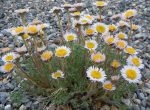 Also known as cutleaf daisy and trifid mountain fleabane, this herbaceous rhizomatous perennial is a member of the aster family, Asteraceae, that also includes daisy, sunflower and lettuce. It is an Arctic and alpine species found in western US from the Pacific Coast to the Dakotas, Colorado, and New Mexico where they grow on cliffs rocky slopes and talus, as well as in woodland edges, meadows and plains. Plants have a stout taproot and spread by rhizomes to form small clumps. They grow up to 10″ tall and have thick unbranched green or red hairy stems bearing a clump of hairy 2″ long leaves that are finely divided into linear lobes. In summer, flowerheads are carried singly on almost leafless stems and consist of 20-60 white, pink or blue ray flowers around a center of several dozen yellow disc flowers. Two or three rows of green or purple bracts covered with white hairs surround each flowerhead. Plants are tolerant of drought and salt and are good choice for a rock, alpine, wildflower, seaside or native plant garden. The genus name, Erigeron, comes from the Greek words eri meaning early and geron, meaning old man, referring to the early appearance of the type species and the hairiness of the plant parts that suggest the beard of an old man. The specific epithet, compositus, is the Latin word for compound, and refers to the divided nature of the leaves.
Also known as cutleaf daisy and trifid mountain fleabane, this herbaceous rhizomatous perennial is a member of the aster family, Asteraceae, that also includes daisy, sunflower and lettuce. It is an Arctic and alpine species found in western US from the Pacific Coast to the Dakotas, Colorado, and New Mexico where they grow on cliffs rocky slopes and talus, as well as in woodland edges, meadows and plains. Plants have a stout taproot and spread by rhizomes to form small clumps. They grow up to 10″ tall and have thick unbranched green or red hairy stems bearing a clump of hairy 2″ long leaves that are finely divided into linear lobes. In summer, flowerheads are carried singly on almost leafless stems and consist of 20-60 white, pink or blue ray flowers around a center of several dozen yellow disc flowers. Two or three rows of green or purple bracts covered with white hairs surround each flowerhead. Plants are tolerant of drought and salt and are good choice for a rock, alpine, wildflower, seaside or native plant garden. The genus name, Erigeron, comes from the Greek words eri meaning early and geron, meaning old man, referring to the early appearance of the type species and the hairiness of the plant parts that suggest the beard of an old man. The specific epithet, compositus, is the Latin word for compound, and refers to the divided nature of the leaves.
Type: Herbaceous perennial
Bloom: Single daisy like flowers with yellow centers and white, blue or pink ray flowers in summer
Size: 8-10″ H x up to 12″ W (clump)
Light:Full sun
Soil:Average, moderately moist, very well-drained
Hardiness: Zones 2-7
Care: Deadhead to prolong bloom time: cut to the ground in fall; divide in spring or fall every 2-3 years.
Pests and Diseases:None of significance
Propagation:Seed, division
Companion Plants:Artemsia ‘Nana’, Alpine pink, alpine phlox
Photo Credit: Wikipedia